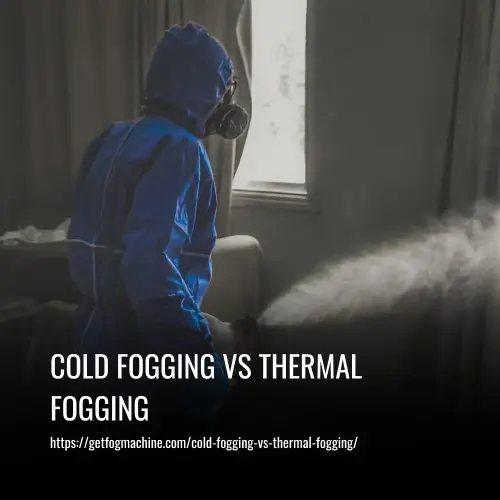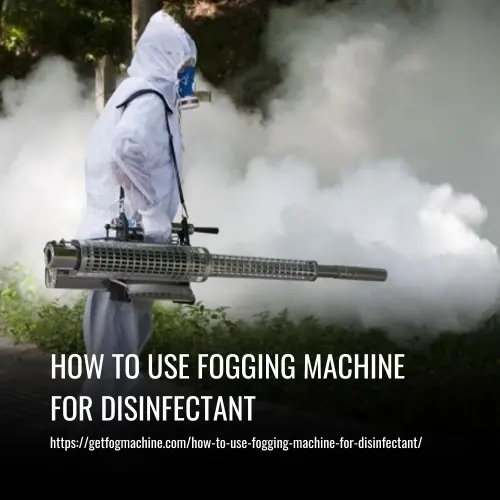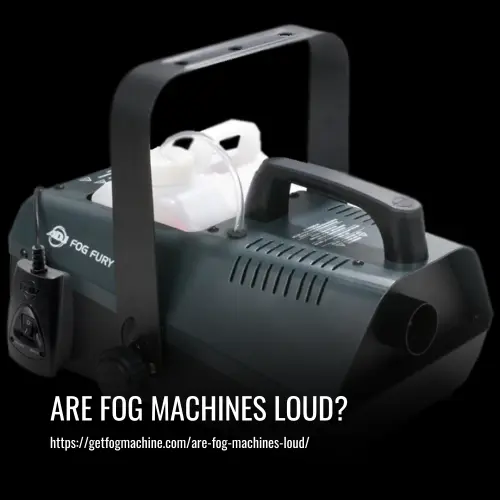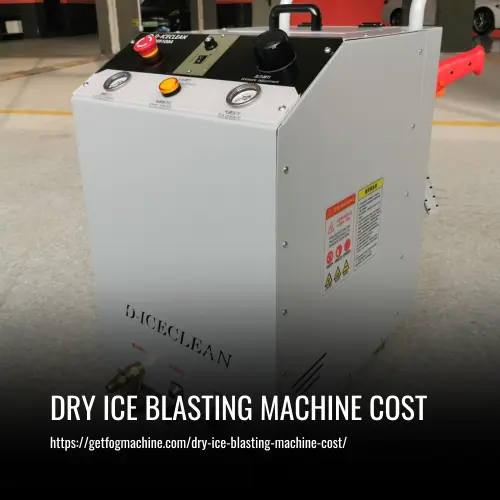The main difference between cold fogging and thermal fogging is the method used to create the fog. Cold fogging, also known as ULV fogging, uses air pressure to spray the liquid application in small particles. On the other hand, thermal fogging uses heat to vaporize the fogging liquid and create the fog.

The Differences Between Cold Fogging And Thermal Fogging
Cold fogging and thermal fogging are two different methods of disinfection and spraying. While both use machines to transform liquid solutions into fog, there are distinct differences in how they operate and the results they produce.
Cold Fogging
In cold fogging, the fog machine does not require the use of heat. Instead, it uses high pressure to convert the liquid solution into airborne particles. By spinning the airflow around the solution, the machine creates a cool fog that disintegrates as it spreads throughout the room. This process is automatic and does not require constant operator intervention.
Cold fogging is a safe method that can effectively disinfect large areas without causing damage. The size of the droplet can be adjusted using a knob, allowing for control over the density and coverage of the fog. This makes cold fogging suitable for applications such as mosquito control, insect control, mold control, odor control, and even outdoor pest control.
Thermal Fogging
Thermal fogging, on the other hand, involves the use of heat to transform the solution into fog. The heated barrel causes the liquid solution to evaporate, producing tiny particles of fog. This fog is dense and easily visible during spraying, allowing operators to see the treated area.
Thermal fogging machines require constant supervision by trained operators due to the high temperatures involved. The heat in the fogging process ensures that the fog penetrates cracks in walls and narrow spaces efficiently, making it suitable for indoor spaces or areas with specific pest control needs.
Energy Source and Operational Differences: Cold Fogging Vs. Thermal Fogging
Cold fogging and thermal fogging are two different methods used for pest control, mosquito control, mold control, and odor control. These methods differ in their energy source and operational processes.
Energy Source
Thermal foggers require the usage of a fuel source, typically propane gas, which is used to heat the fogging solution. On the other hand, cold fogging devices operate on electricity or battery power, eliminating the need for fuel.
Operation
Thermal fogging machines are equipped with heated barrels that are preheated to extremely high temperatures using fuel. This heat vaporizes the fogging solution, creating a dense cloud of fog consisting of a high number of particles in the 0.5-10 micron range when the fogger is operated at full capacity.
In cold fogging, the machines use motors to generate a high-power, low-pressure air stream. The fogging solution is stored in a tank and forced out by a pump. The solution is then injected into a nozzle that swirls the airflow as it passes through, creating tiny droplets in the 5-30 micron range. The high air pressure divides the solution into these fine particles.
Differences in Particle sizes Between Thermal Foggers and Cold Foggers
Thermal foggers and cold foggers are two commonly used fogging machines for pest control, disinfection, mold control, and odor control. One important factor to consider when choosing between them is the particle size they produce.
Thermal Foggers
Thermal foggers utilize a heating assembly to heat the fogging solution, producing very small particles. These foggers typically generate particles within the range of 0.5-10 microns. The heat in the fogging process allows for the vaporization of the solution into water droplets, creating a dense cloud of fog.
This small droplet size enables the fog to penetrate narrow indoor and outdoor spaces, including cracks in walls and floor gaps. The fog produced by thermal foggers is easily visible, allowing for better control and direction of the fogging process.
Cold Foggers
On the other hand, cold foggers, also known as ULV (Ultra-Low Volume) foggers, produce slightly larger particles compared to thermal foggers. The particle size of cold foggers can range from 5-30 microns, depending on the specific model and flow rate adjustment.
Unlike thermal foggers, cold foggers produce a consistent particle size, making them suitable for various applications. They are especially useful for fogging large outdoor areas or indoor spaces where a more consistent distribution of the fog is required. Additionally, cold foggers require less diluent, allowing for the use of more concentrated fogging solutions.
Uses of Thermal Foggers and Cold Foggers
Thermal foggers and cold foggers are both commonly used devices for spraying water or oil-based fogging solutions in various applications. While they have similar uses, there are specific areas where each type of fogger is better suited.
Where to Use a Thermal Fogging Machine
Thermal fogging machines are versatile devices that can be used in various settings for different purposes. Their ability to produce a visible fog and generate finer particle sizes makes them especially effective in certain applications. Here are a few areas where thermal fogging machines are commonly used:
1. Outdoor Insect Control
Thermal fogging machines are excellent for outdoor insect control, particularly for mosquitoes and pests in agricultural settings, barns, and outdoor community arenas. The visible fog and smaller particle size produced by these machines allow the chemicals to disperse more easily in outdoor spaces. The treatment remains in the air for longer periods, enhancing its effectiveness in mosquito and pest control.
2. Odor & Smoke Remediation
Due to their ability to penetrate cracks and crevices, thermal fogging machines are highly effective in odor and smoke remediation. The super-fine fog generated by these machines can reach areas where smoke and odors can infiltrate, making them an optimal choice for eliminating unwanted odors and smoke-related issues. Thermal fogging machines are particularly beneficial when the source of the problem is located behind barriers that need to be penetrated to effectively neutralize the odor or smoke.
3. Indoor Spaces and Narrow Gaps
Thermal fogging machines can also be used for treating indoor spaces and narrow gaps. The fog produced by these machines can reach confined areas, such as crawlspaces, attics, and cracks in walls, where pests, molds, or unpleasant odors may be present. This makes thermal fogging machines a valuable tool in controlling and eliminating various issues in indoor spaces.
Where to Use a Cold Fogging Machine
Cold fogging machines, also known as ULV foggers or ultra-low volume foggers, are versatile tools that can be used in various settings for different purposes. Here are some key areas where cold fogging machines can be effectively utilized:
1. Disinfecting
Cold foggers are particularly well-suited for applying disinfectant in environments that require thorough sanitization, such as schools, clinical settings, gyms, and other indoor areas. These machines can disperse disinfectants in fine droplets, allowing them to reach all surfaces and effectively eliminate harmful bacteria and viruses. Most disinfectants need to be applied wet and allowed to dry for maximum effectiveness, making cold fogging machines an ideal choice.
2. Mold Control
When dealing with serious mold intrusion, cold foggers can be left operating in enclosed spaces to saturate the air and eliminate mold and spores. This makes them highly effective in combating mold in areas like homes, offices, and even greenhouses and plant nurseries. The fine droplets generated by cold foggers can reach deep into cracks and crevices, ensuring comprehensive mold treatment.
3. Indoor Pest Control
Cold foggers are the preferred option for indoor pest control due to their safe operation in enclosed spaces. They can effectively target and eliminate pests such as mosquitoes and spiders in homes, offices, and other indoor areas. Additionally, cold fogging machines can be used around foundations, on decks and patios, and around windows and doors for outdoor pest control.
Advantages And Disadvantages: Cold Fogging Vs. Thermal Fogging
Thermal fogging and cold fogging are two commonly used techniques for controlling pests, insects, and mold in various settings. Each method has its advantages and disadvantages. Let’s take a look at the pros and cons of both fogging techniques.
Advantages of Thermal Fogging
1. Dense, visible fog
Thermal fogging produces a clearly visible fog in all directions. This allows better control and tracking of the fog’s flow, making it easier to direct the fog to specific areas.
2. Increased trust and peace of mind
The visual fog created during thermal fogging reassures clients that action is being taken to address their problems. It enhances trust in the abilities of the fogging operator.
3. Effective in hidden areas
Thermal fogging machines produce extremely small droplets that can penetrate tiny cracks and crevices, ensuring thorough treatment even in hard-to-reach places. The small particle size also allows the fog to remain suspended in the air for longer periods, increasing the chances of contact with flying insects like mosquitoes.
4. Efficiency
Thermal fogging requires lower insecticide concentrations, sprays more insecticide with less energy, and treats areas faster than cold fogging. This makes it a more efficient option for pest control.
Disadvantages of Thermal Fogging
1. High fuel consumption
Thermal fogging devices use a lot of fuel, making this method generally more expensive than cold fogging. Frequent refueling or replacement of fuel can increase overall fogging costs.
2. Unpleasant odor and stains
The fuel used in thermal fogging can have a strong odor, which can be unpleasant for operators and people near the fogging device. The fuel can also leave behind greasy stains that are difficult to remove, posing challenges for fogging in enclosed spaces.
Advantages of Cold Fogging
1. Cost-effective
Cold fogging requires fewer droplets of fogging liquid and fuel per application, reducing the overall cost of fogging. Since it utilizes electricity, it is less expensive than thermal fogging.
2. No residue or fire hazard
Cold fogging does not leave greasy residues and has a lower fire hazard compared to thermal fogging. It is a safer option in enclosed spaces.
Disadvantages of Cold Fogging
1. Almost invisible fog
The fog produced by cold fogging is nearly invisible, making it difficult to monitor and control its direction, especially in outdoor applications. This makes it less effective for mosquito control.
2. Larger droplets
Cold fogging produces larger particles that may struggle to penetrate into small and hard-to-reach areas, both indoors and outdoors. The larger droplets also stay in the air for a shorter duration, reducing their efficacy in mosquito control.
The Relationship between Cold Fogging and Thermal Fogging
Cold fogging and thermal fogging are two methods used for fogging operations. Both methods can utilize water-based and oil-based solutions, offering versatility in application. However, it is important to note that water-based solutions are more environmentally friendly, allow for fogging of plants, and do not pose a fire hazard.
Additionally, water-based solutions are more cost-effective as they do not cause equipment corrosion. Therefore, the relationship between cold fogging and thermal fogging lies in the ability to choose between water-based and oil-based solutions, with water-based solutions being the preferred option for their environmental benefits and cost savings.
FAQs
A cold fogger, also known as a ULV (Ultra Low Volume) fogger, is a device used to disperse pesticide chemicals as a fog or mist in the air. Pest control professionals often use cold foggers to target nuisance pests like mosquitoes, flies, and other flying insects. The fogging method effectively eliminates these pests.
Thermal fogging machines are not only useful for combating pest invasions and thoroughly cleaning spaces, but they are also effective in preventing mold outbreaks and eliminating odors. The tiny particles produced by thermal foggers can penetrate small spaces both indoors and outdoors, creating a dense cloud of fog that reaches cracks in walls and narrow spaces.
There are two main types of fogging machines: thermal foggers and cold foggers (ULV foggers). Thermal foggers use heat to create very tiny particles, while cold foggers disperse fog through air pressure. Each type has its own advantages and applications.
Thermal foggers use a heating process to create very small particles, as small as 0.5 microns, which can penetrate small spaces both indoors and outdoors. The fogging solution is vaporized and expelled as a fog cloud, creating a dark and heavy layer of fog that effectively distributes the insecticide or other solution.
Thermal foggers reach high temperatures, up to about 1000°C. Due to safety reasons, thermal foggers are not preferred for indoor use. Fuel-based thermal foggers contain inflammable liquids, which can cause accidents in enclosed indoor areas.
Cold fogging treatments have shown to be effective in killing up to 99 percent of native adult and caged test mosquitoes. Cold foggers, or ULV foggers, release very tiny aerosol droplets that stay in the air and kill adult mosquitoes on contact.
Some known adverse reactions to thermal fogging include itching, burning, prickling sensations on the skin, headaches, convulsions, tremors, facial flushing and swelling, asthma, sneezing, nasal congestion, and nausea. It is important to use thermal foggers with caution and follow safety guidelines.
Mosquito control professionals often use pyrethrin as an ultra-low volume (ULV) spray in cold fogging treatments. ULV sprayers release very tiny aerosol droplets that stay in the air and kill adult mosquitoes on contact. After spraying, the pyrethrin settles onto the ground and flat surfaces.
When used with the right disinfectant, thermal foggers are generally considered safe and environmentally friendly. Thermal foggers can cover larger areas in a short time, making them efficient for disinfecting outdoor and indoor spaces. However, it is essential to use appropriate disinfectants and follow safety precautions.
Conclusion
In conclusion, both cold fogging and thermal fogging are effective methods for pest control, odor control, mold control, and disinfection. Cold fogging machines, which use air pressure to create a fine mist of droplets in the 0.5-10 micron range, are ideal for outdoor applications and covering large areas. They are efficient in controlling pests and can deliver the fogging solution evenly.
On the other hand, thermal fogging machines use heat in the fogging process to convert liquid solutions into water droplets, producing a dense cloud of fog. They are effective in reaching narrow and indoor spaces, penetrating even cracks in walls and floor gaps. The larger droplet size in the 5-30 micron range ensures better coverage and allows for the use of special chemicals such as disinfectants.
Ultimately, the choice between cold fogging and thermal fogging depends on the specific needs of the situation.




